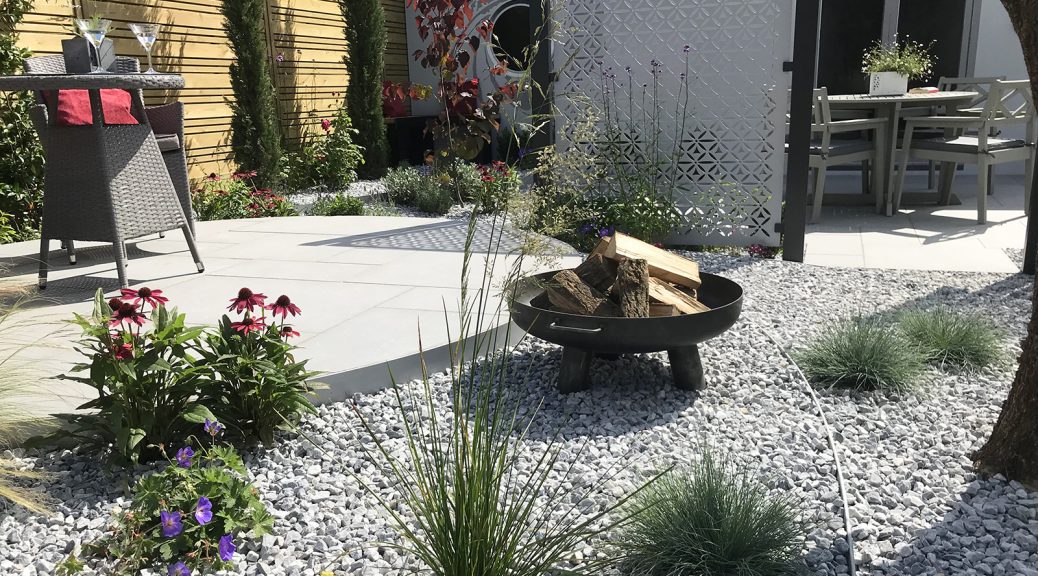
Combining Paving with Decorative Gravel and Stones
When designing your patio or garden path, remember that there are no hard-and-fast rules about using just one material type in a particular area. Combining paving with decorative gravel and stones is a fantastic way to create a unique and cost-effective finish to your garden.
Here we are going to look at some things to consider when linking together paving slabs with other gravels or stones.

Left: The use of blue slate with grey paving slabs perfectly complements each other for a cohesive finish. This timeless look really allows the plants stand out as the stars of the show!
Get the look – Blue slate 20mm
Initial considerations
Gravel is much easier and more forgiving than filling the spaces between paving slabs with mortar. Using decorative aggregates to fill the gaps between slabs also helps prevent rainwater runoff and provides a sustainable drainage solution.
Using traditional fixing and filling methods, such as mortar, can lead to an increased demand on mains drainage systems. This can cause problems when this system becomes overwhelmed during times of high rainfall in areas where there is little natural drainage. So, gravel can provide not only a more ecologically friendly solution, but gives a more natural aesthetic too.

Size matters
Once you have determined that you want to intersperse decorative aggregates and paving slabs you will want to think about the size of your pavers and also the size of the gap you want to leave between them.
Think about the shape of your paving slabs. Square paving offers a tidy but modern feel to your space; whilst irregular, natural stone paving gives a more organic appearance. The larger the size of the paving and the gap left between, the larger the filler stone can be. Even a stone sized up to that of a small pebble in the space between paving slabs can look really effective.
One thing you want to watch for is that the size of stone that you do choose is not too small. If the stone is too small it will get lodged into the soles of people’s shoes. Generally we would suggest a stone size no smaller than 10mm to prevent this from happening.
Choosing the right decorative aggregate
First you want to consider the colour of your paving. Then think, do you want to complement the colour of the paving or do you want a contrast? In our experience both work equally as well, it really is down to your individual choice and what you want to achieve with the overall finished look.

Above: Contrasting stepping stones against the lighter Ice Blue Chippings. A contrasting finish such as this can add more interest to the space, whereas complementing schemes can feel more soothing. Planting directly through the surface of the gravel looks great, and is also really important for wildlife.
Get the look – Ice Blue Chippings 20mm
When you have narrowed down to an idea of the colour, you want to consider the type of stone you want to use. Do you want gravel, slate or larger stones / pebbles? Deciding what colour you want to use will narrow down your choice of available aggregates; for instance, you won’t get a cream coloured slate. So check out the available materials in the colour scheme that you want and decide what shape and size you like in the colour you are looking for. Do you want a nice rounded stone or an angulated, crushed stone? Each has different properties in the way it lays on the ground and offers a different textural styles to the landscape.

The choice of filler you decide on will need to be quite stable. Even though on the whole it won’t be walked on, as the paving slab itself will be where most people choose to tread – you can’t say the same for pets and children however! There is nothing messier than a path with stones scattered all over it.
To try and limit this problem lay filler stone between paving slabs at a height slightly lower than the surface of the slab, unless you really enjoy sweeping slabs free from loose stones!
Making your project unique
The use of larger stones can be used around the patio or to edge beds and borders. Some types of stones come in a range of sizes such as Scottish and Duck Egg. These stones are perfect for using in different areas of the garden and keeps the theme going throughout.
When combining paving with decorative gravel and stones, flower pots can be placed on the paving or the gravel stones. These pots can be natural earthenware to blend in to the natural feel of the garden, or they can be glazed in bright colours to bring your unique design qualities to life.

Above: A complementing colour scheme with this stepping stone path. Plants often thrive thanks to the free drainage created by gravel stones.
Get the look – Yorkshire Cream ? Paving According to what’s in
In Conclusion
Decorative aggregates as patio paving fillers serve many purposes. Not only do they look great, but they come in a huge variety of colours and textures to complement and contrast any landscaping scheme.
Choosing an aggregate as a filler between paving slabs can also help with drainage and offers a more environmentally friendly alternative to the traditional finished patio and flagged paths with cement fillers. Aggregates offer a softer, more natural feel and break up the harshness that a fully flagged area can have.
Decorative aggregates can also provide a home and shelter to insects, increasing biodiversity within even the smallest space. As you can see from some of the images, it is great to have plants growing directly from aggregate. This further softens the look, providing a more natural and less staged feel to the garden.
So next time you are looking at a garden revamp, why not consider combining paving with decorative gravel and stones!